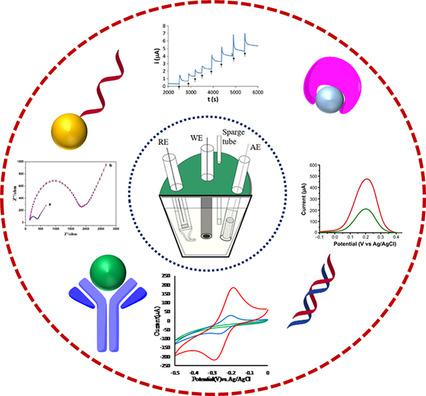当前位置:
X-MOL 学术
›
Electroanalysis
›
论文详情
Our official English website, www.x-mol.net, welcomes your feedback! (Note: you will need to create a separate account there.)
Ultrasensitive Bioaffinity Electrochemical Sensors: Advances and New Perspectives
Electroanalysis ( IF 3 ) Pub Date : 2018-10-10 , DOI: 10.1002/elan.201800598 Negar Alizadeh 1 , Abdollah Salimi 1, 2
Electroanalysis ( IF 3 ) Pub Date : 2018-10-10 , DOI: 10.1002/elan.201800598 Negar Alizadeh 1 , Abdollah Salimi 1, 2
Affiliation

|
This article reviews recent advances and developments in the field of bioaffinity electrochemical sensors with emphasis on a subclass including immunosensors, aptasensors, genosensors and molecularly imprinted sensosr. Recent insights into novel fabrication methodologies and electrochemical techniques have resulted in the demonstration of biosensors able to detection of wide range of target analyte. It has been shown that due to their high specificity and sensitivity, they represent a great tool in practical applications. Furthermore, at last couple decades nanotechnology has become very popular in the sensor fields due to the high capacity of nanomaterials to immobilize of bioaffinity agents and also their inhibiting effects on denaturation of enzymes and other bioaffinity systems, which they could well have beneficial effects for the performance of these sensors. The main focus of this review is to discuss methods for immobilizing bioreceptors onto a solid support, introduction of nanomaterials for improve sensitivity of biosensor and various electrochemical sensing platforms. The use of biosensor in these applications is most appropriate, because the analysis of trace substances in medical and healthcare applications, environmental science, and food industries is so important. In addition, recent advances in nanomaterial‐mediated bioaffinity sensors used for onset biosensing, point‐of‐care testing and healthcare management are also highlighted.
中文翻译:

超灵敏生物亲和电化学传感器:进展和新观点
本文回顾了生物亲和电化学传感器领域的最新进展和发展,重点是一个子类,包括免疫传感器,适体传感器,基因传感器和分子印迹传感器。对新型制造方法和电化学技术的最新见解已导致能够检测多种目标分析物的生物传感器得到了证明。已经表明,由于它们的高特异性和敏感性,它们在实际应用中代表了很好的工具。此外,由于纳米材料具有固定生物亲和剂的高能力以及它们对酶和其他生物亲和系统变性的抑制作用,最近二十年来,纳米技术已在传感器领域变得非常流行。它们很可能对这些传感器的性能产生有益的影响。这篇综述的主要重点是讨论将生物受体固定在固体支持物上的方法,引入纳米材料以提高生物传感器的灵敏度以及各种电化学传感平台。在这些应用中最适合使用生物传感器,因为在医疗和保健应用,环境科学和食品行业中对痕量物质的分析非常重要。此外,还着重介绍了纳米材料介导的生物亲和力传感器的最新进展,这些传感器用于发病生物传感,即时检验和医疗保健管理。引入纳米材料以提高生物传感器和各种电化学传感平台的灵敏度。在这些应用中最适合使用生物传感器,因为在医疗和保健应用,环境科学和食品行业中对痕量物质的分析非常重要。此外,还着重介绍了纳米材料介导的生物亲和力传感器的最新进展,这些传感器用于发病生物传感,即时检验和医疗保健管理。引入纳米材料以提高生物传感器和各种电化学传感平台的灵敏度。在这些应用中最适合使用生物传感器,因为在医疗和保健应用,环境科学和食品行业中对痕量物质的分析非常重要。此外,还着重介绍了纳米材料介导的生物亲和力传感器的最新进展,这些传感器用于发病生物传感,即时检验和医疗保健管理。
更新日期:2018-10-10
中文翻译:

超灵敏生物亲和电化学传感器:进展和新观点
本文回顾了生物亲和电化学传感器领域的最新进展和发展,重点是一个子类,包括免疫传感器,适体传感器,基因传感器和分子印迹传感器。对新型制造方法和电化学技术的最新见解已导致能够检测多种目标分析物的生物传感器得到了证明。已经表明,由于它们的高特异性和敏感性,它们在实际应用中代表了很好的工具。此外,由于纳米材料具有固定生物亲和剂的高能力以及它们对酶和其他生物亲和系统变性的抑制作用,最近二十年来,纳米技术已在传感器领域变得非常流行。它们很可能对这些传感器的性能产生有益的影响。这篇综述的主要重点是讨论将生物受体固定在固体支持物上的方法,引入纳米材料以提高生物传感器的灵敏度以及各种电化学传感平台。在这些应用中最适合使用生物传感器,因为在医疗和保健应用,环境科学和食品行业中对痕量物质的分析非常重要。此外,还着重介绍了纳米材料介导的生物亲和力传感器的最新进展,这些传感器用于发病生物传感,即时检验和医疗保健管理。引入纳米材料以提高生物传感器和各种电化学传感平台的灵敏度。在这些应用中最适合使用生物传感器,因为在医疗和保健应用,环境科学和食品行业中对痕量物质的分析非常重要。此外,还着重介绍了纳米材料介导的生物亲和力传感器的最新进展,这些传感器用于发病生物传感,即时检验和医疗保健管理。引入纳米材料以提高生物传感器和各种电化学传感平台的灵敏度。在这些应用中最适合使用生物传感器,因为在医疗和保健应用,环境科学和食品行业中对痕量物质的分析非常重要。此外,还着重介绍了纳米材料介导的生物亲和力传感器的最新进展,这些传感器用于发病生物传感,即时检验和医疗保健管理。


























 京公网安备 11010802027423号
京公网安备 11010802027423号